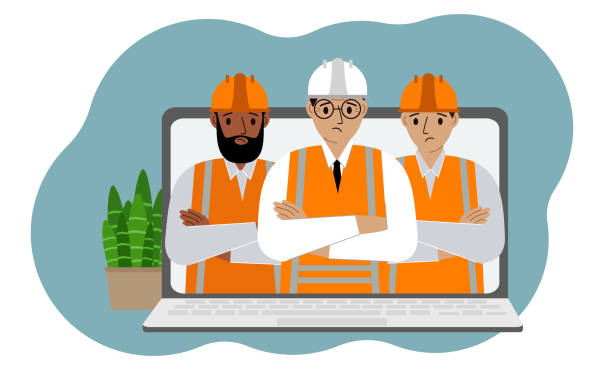The contracting industry has never stood still. Materials evolve, customer expectations shift, and job sites demand new approaches to efficiency. But what’s happening right now is less about hammer and nail innovation and more about how technology is reshaping the way contractors organize, communicate, and deliver. For many, the shift has been gradual: learning how to fit digital tools into a trade built on skill and labor. For others, it’s a rapid adaptation to survive in a climate where clients expect updates, clarity, and speed. What unites both groups is the recognition that staying ahead requires more than skillful hands. It takes a willingness to embrace tools that expand what a contractor can do.
The Modern Job Site
Walk onto a job site today and you’ll see the familiar: crews setting up scaffolding, electricians running wiring, and roofers balancing their footing against the wind. But alongside this picture of physical work is a less visible force, software managing the flow of tasks, assignments, and communication. Contractors are no longer flipping through notebooks or chasing down missed calls. They’re opening apps that give them a bird’s-eye view of projects while still being able to zoom in on details like delivery times or subcontractor schedules.
What’s striking is how much this digital shift has changed the rhythm of work. Instead of bottlenecks slowing down projects, teams now rely on platforms that cut down on confusion. Subcontractors who used to lose hours waiting for approvals can now send updates directly through their phone. Crews can track progress in real time, and project managers can share that information with clients almost instantly. The job site hasn’t gone soft—it’s gotten sharper, faster, and in many ways, less frustrating.
Technology As A Second Set Of Hands
For contractors, technology doesn’t replace craftsmanship. No app is going to hang drywall or weld a joint. But what it does provide is a kind of second set of hands—an invisible helper that keeps projects from slipping through the cracks. Scheduling tools keep everyone aligned, digital blueprints update instantly across devices, and estimates can be generated without waiting days for callbacks.
This matters because time lost is money lost, and clients aren’t shy about pushing for faster turnarounds. Contractors using modern software are finding that not only does it help their teams stay efficient, it also builds trust with customers who appreciate transparency. A homeowner watching their project move forward with clear updates is far less anxious than one left wondering when someone will show up. That trust, once established, becomes repeat business. In an industry that thrives on referrals and reputation, technology has become one of the strongest allies a contractor can have.
Tracking Time The Smart Way
One of the most practical ways technology has stepped in is with technician accountability. Contractors with teams spread across different job sites know the headache of tracking hours, making sure work is logged correctly, and confirming that projects are moving as planned. Enter the wave of apps that provide technician time tracking. Instead of relying on handwritten timesheets or the honor system, these tools create a clear record of when and where work is done.
For contractors juggling multiple projects, this removes a lot of guesswork. It also strengthens client relationships. If a customer questions a bill or wants to understand where labor hours went, contractors can pull up detailed logs without hesitation. What might once have turned into an uncomfortable back-and-forth can now be resolved in minutes. The result is less friction, more clarity, and a smoother workflow for everyone involved.
When The Roof Needs Repair
Technology’s role shows up clearly in urgent situations. Take something as common as a homeowner calling to say their roof needs repair. That request can spiral if communication isn’t handled well—materials need to be checked, crews assigned, and timelines confirmed. Without the right systems in place, delays pile up quickly. But contractors using integrated platforms can respond faster, schedule the right team, and get accurate estimates out without losing days in the shuffle.
For the homeowner, this speed is everything. They don’t want to wait while leaks worsen or weather damage spreads. For the contractor, it shows competence and care. In competitive markets, being the one who can deliver fast, accurate service while still keeping the quality high often makes the difference between winning a job and losing it. Technology may not stop the rain, but it certainly makes it easier to handle the storm.
The New Standard In Mobile Tools
What’s driving the next leap forward isn’t just software in the office—it’s mobile access on the job site. Contractors have begun to expect the same level of connectivity in the field as they do at a desk, and the best platforms are delivering exactly that. BuildOps, for example, explains this on their website clearly. These mobile apps give technicians everything they need to do the job right—no calls, no clutter, no confusion. It’s simple to use and powerful where it counts. That kind of accessibility means fewer dropped tasks, quicker updates, and a smoother connection between what happens in the field and what’s managed in the office.
This is important for scaling, too. A contractor managing a small crew may not feel the strain of miscommunication the way a company with dozens of technicians does. But as businesses grow, so do the opportunities for mistakes. Having a mobile-first system in place prevents those mistakes from spiraling, and it gives owners confidence that their teams are equipped to handle the pace of modern contracting.
Building The Future Of Contracting
It’s tempting to think of technology as an add-on, a nice tool to have when budgets allow. But contractors who’ve leaned into it know it’s far more than that. It’s part of building resilience into their businesses. From weather delays to supply chain hiccups, there’s always going to be something unexpected on a project. The difference between companies that bend and those that break often comes down to whether they’ve given themselves the infrastructure to adapt quickly.
Clients notice this, too. A contractor who can explain delays, provide updates, and adjust schedules on the fly earns more respect than one who leaves people in the dark. That reputation spreads fast. Just as skill with a hammer once set a builder apart, skill with digital tools now signals to clients that a contractor is serious, professional, and ready for modern challenges.
Looking Ahead
What’s emerging is a contracting industry that blends the grit of hands-on work with the intelligence of digital systems. It doesn’t diminish the craftsmanship that defines the trade. If anything, it makes room for contractors to focus on what they do best—building, repairing, creating—while letting technology handle the tangle of coordination. Contractors who’ve made the shift know it’s not about replacing tradition but about strengthening it.
The next decade won’t be kind to businesses that ignore these changes. Clients will expect transparency, employees will prefer companies that invest in tools to make their jobs easier, and efficiency will separate those who thrive from those who just scrape by. Contractors have always prided themselves on working smarter, not just harder. Today, that wisdom extends to the digital side of the trade, where adopting the right tools isn’t optional anymore. It’s the new standard.






